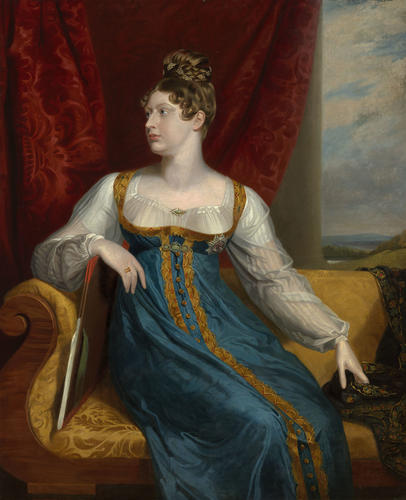Princess Charlotte of Wales (1796-1817) c. 1817-25
Oil on canvas | 132.0 x 107.5 cm (support, canvas/panel/stretcher external) | RCIN 402491
-
Princess Charlotte is seated elegantly on a chaise longue, dressed in her blue silk Russian-style dress, beneath which is a plain white undergarment. At her left breast she wears the star of the Order of St Catherine, which she received on 1 July 1817, from Maria Feodorovna, wife of Paul I, in gratitude for hospitality shown to her son Nicholas during his visit to London. (Princess Charlotte’s husband, Prince Leopold of Saxe-Coburg, also served under the Russian Emperor during the Napoleonic Wars.) The portfolio beneath her arm may contain etchings and allude to her artistic endeavours. The way in which the body turns extravagantly, the legs almost in profile, the chest seen frontally and the head almost in opposite profile, suggests that Dawe has been looking at Classical reliefs where such effects are common. It is perhaps significant that the Elgin Marbles were put on display at the British Museum in 1816, a year before the original portrait was painted.
The portrait is a contemporary version of the full-length painting in the Belgian Royal Collection, dated 1817. The image was widely published, most notably by William Say (1768– 1834) on 1 December 1817 and by Henry Dawe on 12 January 1818 (RCIN 605420). This variation differs in that the Princess wears the star of the Order of St Catherine, and her hair is dressed in a simpler manner. Another autograph version of the painting, in reverse, with an elaborate lace blouse and without roses in her hair, is in the National Portrait Gallery (NPG 51). This was said to be the first depiction of the Princess by the artist and to have remained with him throughout his life There is a further small version in the Royal Collection (RCIN 406478). Dawe exhibited two portraits of the Princess at the Royal Academy, in 1817 and 1818.
The painting was ascribed to Benjamin Robert Haydon (1786–1846) when it entered the Collection during the reign of Edward VII, although there is little evidence that the artist worked as a copyist, despite his financial difficulties. A version by Dawe was sold in the Duke of Cambridge’s sale, in 1904, although the present painting is not believed to be that version.
Having begun life as a mezzotint engraver, George Dawe was much employed as a painter by Prince Leopold both during his marriage (1816-7) and after; he worked also for the Duke and Duchess of Kent. Like Lawrence he was at Aix-la-Chapelle to paint the crowned heads assembled there for the Congress in 1818. He spent the years 1818-28 working for the Emperor Alexander I in St Petersburg, creating 336 portraits of those responsible for the defeat of Napoleon, housed in a specially-created gallery in the Winter Palace (the equivalent of the Waterloo Chamber). He died soon after his return to England in 1829.
Text adapted from Russia: Art, Royalty & the Romanovs, London, 2018
Provenance
First recorded in Victoria Tower at Windsor Castle in 1905 (WC no 2876) and in 1909 at Buckingham Palace (Cust 1909, p 185), in both cases attributed to Benjamin Robert Haydon
-
Creator(s)
Acquirer(s)
-
Medium and techniques
Oil on canvas
Measurements
132.0 x 107.5 cm (support, canvas/panel/stretcher external)
157.2 x 136.0 cm (frame, external)
Category
Object type(s)
Other number(s)
Alternative title(s)
Princess Charlotte Augusta of Wales (1796-1817)









